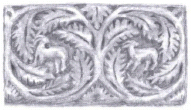
Although modern photography began in 1839, in the 1920s photography was still thought of as so new that many people were only just beginning to think of it as art. For centuries, painters had already been perfecting lighting and composition (or how to arrange a picture). To prepare Yousuf to be a camera artist, Garo insisted he find out about all kinds of art.
In the evenings, the hard-working student took art classes. He would never be a painter like Garo, or the best in the class, but Yousuf enjoyed helping the teacher. To prepare for the class, models or objects were posed against background material. He draped, or arranged, the folds of the fabric. As he learned to compose a picture, Yousuf noted the effects of the light and shadow, exactly what a photographer needs to know.
To learn more about paintings, he visited the Museum of Fine Arts, Boston. Once he entered the stately museum, Yousuf dreamed while gazing at the works of famous artists such as El Greco, Rembrandt and Goya. In 1928, he might even have viewed an exhibit of one of the most important photographers of the day, Alfred Stieglitz. Yousuf felt happy and at home in the museum.
In 1907, the Museum of Fine Arts, Boston was housed in an elegant stone building with huge 152-metre (500-feet) high columns beside the doors. Yousuf returned there to hold his first major American show in 1968.

The Museum of Fine Arts, Boston
Garo also sent Yousuf down the street from the studio to look at art books in the Boston Public Library. Statues of some of the world’s greatest thinkers decorated the wide stairs leading to the library building. The words “Free to All” were carved in the stone above the doors. Yousuf was excited to be entering a palace of knowledge, a place for everyone. The library would be another of his special “homes” in Boston.

A photo of Yousuf taken by Garo in 1933